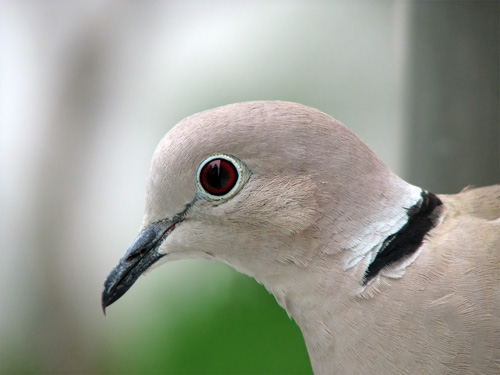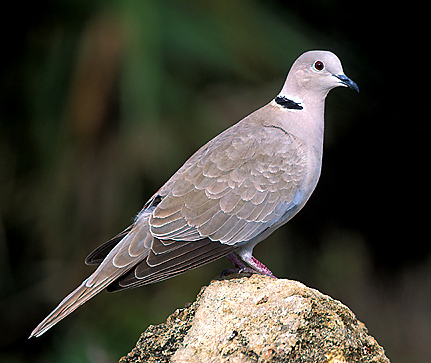
Check that dove at your feeder, it may be a Eurasian Collared Dove. You can distinguish this recent invader from the native Mourning Dove by their larger size and different, slightly lower call with the accent on the second beat. Next, you will note the Eurasian Collared Dove's squared tail, rather than Mourning Dove's pointed tail. The presence of a black half-collar will cinch it.
In Greek, "streptos" means "collar" and "peleia" means "dove", hence the genus name Streptopeleia. The species name recalls an overworked, underpaid servant girl who prayed to the gods for help. They changed her into a dove to escape her misery. The Greeks thought the dove's call, "Decaocto" which translates as "eighteen", echoed the mournful cries of her human existence, therefore, Streptopeleia decaocto, the Eurasian Collared Dove. Its English name derives from the half-collar on its nape.
A closer look reveals short, pinkish-red legs supporting a small, slim dove with long broad wings and a long squared-off tail held closed in flight but fanned in display or on braking to land. The squared off tail sports a prominent black base. The outer half of the tail looks pure white, but the central tail feathers appear grayish. Sexes have similar size; length 11.5 in; wingspan 13.8 in; weight 5-6 oz. The head shows round with a steep forehead, thin dark bill and dark eye in a plain face. At close range, you will pick out the reddish brown iris. The tri-colored wing pattern of this dove becomes visible when the bird displays or lands. The primaries appear black, the body gray and the central wing white. The upper tail shows gray with a broad white outer band.
It nests in trees, laying two white eggs in a stick nest. The female commonly lays three clutches a year and sometimes six. She incubates the eggs during the night and the male takes the day shift. Incubation lasts 14-18 days when helpless young hatch with some down on them. They fledge after 15-19 days. Juveniles resemble adults except for reddish edges to body feathers, brown eyes, and brownish red legs. The Eurasian Collared Dove eats seeds, grains, and berries.
Man influenced the spread of the Eurasian Collared Dove in two ways, adaptation of the environment and domestication of birds. The species occurred historically only in and around India, and a massive expansion in the 1600s brought it into Turkey and the Balkans. It spread, for unknown reasons, northwest into Europe, reached west into Britain by 1953 and now breeds north of the Artic Circle in Scandinavia.
Imported into the Bahamas during the 1970s when a supplier, unable to fill an order of Ringed Turtle-Doves, substituted Eurasian Collared Doves. An aviary break-in resulted in the release of 50 birds in 1974. Within ten years, the population multiplied to at least 10,000 birds,and spread to other islands. By the mid-1980s it reached the North American mainland near Miami, Florida, and expanded its range rapidly. Often kept as a pet, the occurrence of the species in some areas of the United States is traceable to escaped or released cage birds, notably, a well established and isolated population in Los Angeles. The Mendocino Coast saw its first records about five years ago. It is not migratory.
These doves may not have a detrimental impact on native species, and appear to occupy a niche in the well-developed suburbs somewhere between the Rock Doves (Pigeons) in the city and the Mourning Doves in open country. As they expand their range in North America, we will observe their impact on populations of native birds, and learn what ecological and geographical barriers finally limit their range expansion. Like its namesake, Decaocto, the Eurasian Collared Dove escaped its confinement for a better life elsewhere.

Eurasian Collared Dove photo Peter Wallack.